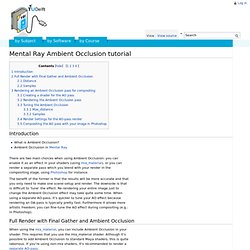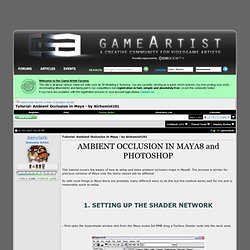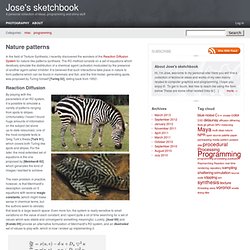

Parametric Urbanism - Urban Reef - by Shampoo. Maya Fluid to Grasshopper link by Matthijs la Roi. Maya Fluid to Grasshopper link by Matthijs la Roi This video shows an experiment by Matthijs la Roi to export the velocity vectors from a Maya Fluid simulation visualised in Rhino with the use of Grasshopper.

This link will be used in the development of interactive pavilion design for the TU campus in Delft the Netherlands. The project is part of the MSc1 Infomatters studio directed by Dr. Nimish Biloria and Ir. Han Feng from the Hyperbody department from the Faculty of Architecture at the Delft University of Technology. Ming3D. Particle Path Trace Here is ta MEL script you can trace the path of particles and create a curve in Maya.

Attached file new animation script Here is the refined version of animation script for Maya 2011. MEL. Maya Tutorials - Extrude Faces and Edges Along Curves in Maya. Spatial Simulation: Andrew F. Scott: Smooth_extrude.mel. After the lecture in class on polygonal modeling and its use for tessellating surfaces and creating structural frameworks I decided to go home and do a little MEL scripting for Maya.

I revisited a script created by Ming Tang call Super Extrude. It is used to generate a lattice forms from a polygonal model using the extrude commands. I decided to extend the script by unlocking the PolyPoke node and adding the duplicate feature to the script so that you retained a copy of your source geometry. In addition I added a chamfer node as well as PolySmooth node. HZnpSoft Creates nParticles for Softbody Dynamics in Maya. Creating a Terrain in Maya using 8 & 16bit Images. Polygon Modeling Tutorial - Proxy Wiki. Fabricating Information : Spring 2008. TOI - [Information] Maya for Students - TU Delft. Nurbs v. polygons v. subdivisons.
Plug-ins. Chad Vernon » Python Scripting for Maya Artists. This workshop is geared towards students with little to no scripting/programming experience.

By the end of this workshop, you will have the knowledge to write and run Python scripts inside and outside of Maya. You will not learn everything about Python from this workshop. This workshop includes all the basic information you should know in order to be proficient in reading, writing, running, and modifying Python scripts. The purpose of this workshop is not to make you expert Python scripters, but to give you a solid foundation from which in further your Python studies. Learning Python, 3rd Edition by Mark Lutz Dive Into Python: The python_inside_maya Google email list: Some Programs that support Python: Maya Modo Houdini XSI Massive Blender Photoshop (indirectly) 3ds max (indirectly) What is Python used for?
Artists can Automate repetitive and/or tedious tasks. Engineers can Create applications and tools to run studio pipelines. Mel Scripts, Maya Plugins, Maya Mel Scripts, Maya Mel, Free Maya Mel Scripts, Free Maya Plugins, Free Mel Scripts. Tutorial_Maya_Vector Render_01. Tutorial_Maya_OBJ-IGES Workflow_01. N_mirrorComponents « Catalin Niculescu. Creating a Bird Auto Rigging Python Script for Maya. DESC9019 - 3D Computer Graphics Concepts. Maya 2009 Tutorial - Blend Shape Deformer. Mental Ray Ambient Occlusion tutorial. Introduction What is Ambient Occlusion?

Ambient Occlusion in Mental Ray There are two main choices when using Ambient Occlusion: you can enable it as an effect in your shaders (using mia_material), or you can render a separate pass which you blend with your render in the compositing stage, using Photoshop for instance. The benefit of the former is that the results will be more accurate and that you only need to make one scene-setup and render. The downside is that is difficult to 'tune' the effect. Full Render with Final Gather and Ambient Occlusion When using the mia_material, you can include Ambient Occlusion in your shader. Not that you need to enable either Global Illumination or Final Gather (or both) to work with the mia material. Tutorial: Ambient Occlusion in Maya - by Alchemist101. AMBIENT OCCLUSION IN MAYA8 and PHOTOSHOP This tutorial covers the basics of how to setup and bake ambient occlusion maps in Maya8.

The process is similar for previous versions of Maya only the menu names will be different. P3D solidify - Free Poly Tools Modeling Scripts. Blobs in Maya – Jose's sketchbook. For this post, I have been working on implementing isosurfaces as a modeling tool in Maya to create things such as the one depicted in the image below. Isosurfaces An isosurface is a shape which is described by taking a and building a surface from all the points on the field of which value matches a given threshold level we provide. Growing organic structures – Jose's sketchbook. This project arose from a conversation with my friend Gino , who is currently working on Medical Visualization, about the difficulty for an artist to create growing structures such as veins -let alone animate them- and how to make them look organic, and therefore irregular and adapted to the surrounding they grow upon.
The Problem I decided to tackle the problem, and the first approach that came to my mind were L-Systems , which have proven useful for modelling vegetation. There are two restrictions, however, which discouraged me from taking this approach: We should be able to bind the growing of the structures to a surface, and therefore the growth needs to be . Nature patterns – Jose's sketchbook. In the field of Texture Synthesis, I recently discovered the wonders of the Reaction Diffusion System for nature-like patterns synthesis.

The RD method consists on a set of equations which iteratively simulate the distribution of a chemical agent (activator) modulated by the presence of another agent called inhibitor. It is believed that such interactions take place in nature to form patterns which can be found in mammals and fish, and the first model, generating spots, was proposed by Turing himself [Turing 52], dating back from 1952!.
Reaction Diffusion By playing with the parameters of an RD system, it is possible to simulate a variety of patterns ranging from spots to stripes. Unfortunately I haven’t found huge amounts of information on the subject (let alone up-to-date resources): one of the most complete texts is Greg Turk’s thesis [Turk 91], which covers both Turing-like spots and stripes. RD Strip system as appears in |Asai 99|. 'Space' key to reset simulation.
References. Voronoi Shattering (Part II) – Jose's sketchbook. This post is a continuation of the first part about my Voronoi Shattering project, please make sure to read it first. Fragment carving On the previous post we left it at the point where we had a Voronoi Diagram generated from a set of points sampled from the source geometry’s volume. We’ll now take it from there and, in this post, I’ll be talking about the mesh slicing. Fig. 1. Autodesk Maya. Chain Blender for Maya.